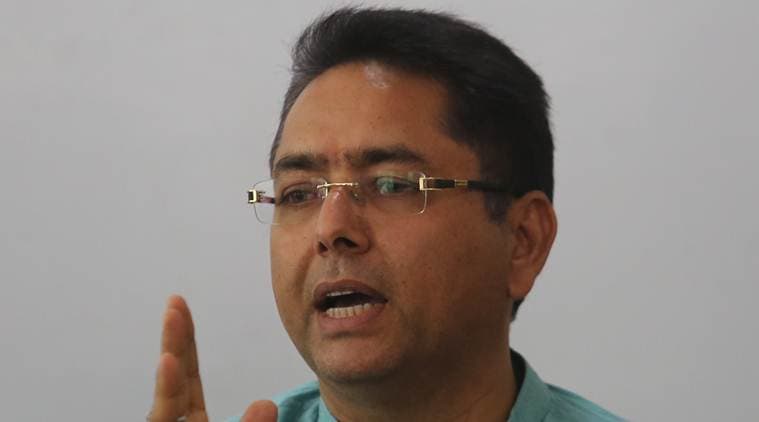 AAP MLA Aman Arora (Express photo by Jasbir Malhi)
AAP MLA Aman Arora (Express photo by Jasbir Malhi)
A day after Punjab government decided to postpone the White Paper on power, initially scheduled to be tabled on the last day of Vidhan Sabha session that concluded on Wednesday, the Aam Aadmi Party (AAP) released a 17-page document it called a “white paper” on Punjab’s power sector.
Releasing the 17-page document prepared by AAP MLA Aman Arora, Leader of Opposition, Harpal Singh Cheema said while the government could not table the White Paper, “they were doing it themselves”.
Joining the clamour to demand renegotiation of controversial Power Purchase Agreements (PPAs), the AAP leader said the were certain that Amarinder Singh’s government would not do anything to make the state’s power cheaper. He accused the government of “taking over the power mafia led by former deputy CM Sukhbir Singh Badal.”
While the Akalis and Congress blame each other for the mess in the power sector of the state, the AAP document blames both the governments equally. According to Arora, AAP has tried to put on paper all that went wrong and who all were responsible. He said the data was sourced from government’s documents.
Jails Minister Sukhjinder Singh Randhawa termed AAP’s white paper “rubbish” . He said the government will bring out its White Paper and the truth will prevail.
Arora said as per his calculations, if the government takes corrective steps, power tariff can be brought down to Rs 3 to 4 per unit for all categories of consumers besides saving PSPCL from ever mounting debt. In his document, Arora has suggested scrapping or renegotiating of PPAs as was done in Water Termination Act , Sewa Kendra Service provider , BLS company agreement and on the basis of Supreme Court judgment that cleared the way for PPA renegotiation in October 2018.
AAP argues that a high-powered all-party Vidhan Sabha Committee should be constituted to renegotiate PPAs.
It claims that PPAs can be amended after an internal audit of highly inflated project cost claims of private thermal plants.
Further, the government, AAP claims, can also cut the cost by resorting to mining of coal from own captive mine at Pachhwara, cutting down of T&D and theft loses, reducing it levies like electricity duty, infra cess, MC tax, cow cess from present Rs 1.33 per unit to UP’s 0.05 paise or Chandigarh’s 0.09 paise which will give a relief of approximately Rs 4000 crore to the people of state.
The AAP white paper also mentions Union Finance Minister’s budget speech suggesting inefficient thermal plants be closed and their land be put to alternate use. Pointing out that Punjab meets its energy requirements from its own sources, it adds that high power tariffs in Punjab complete failure of political leadership of the successive governments, and absence of any long term vision.
Cong rule under AAP scanner
AAP’s white paper claims that during CM Amarinder Singh’s previous regime, his government had approved two Thermal Power Projects of 1000 MW each at Nabha and Banawala (Talwandi Sabo) on Build-Operate-Transfer (BOT) basis in September 2006. It claims that in January 2007, the Punjab State Electricity Board (PSEB) decided to offer the projects to developers on Build-Own-Operate (BOO) basis instead of Build-Own-Operate Transfer (BOOT) basis and increase the capacity from 1000 MW to 1200 MW. This made the thermal plants independent instead
of being owned by the state, says AAP.
PPAs during SAD-BJP rule
The AAP document says, “SAD -BJP cleared three private thermal plants of 3920 MW at NPL Rajpura (1400 MW), TSPL Talwandi Sabo (1980 MW) and GVK Goindwal Sahib (540 MW). Under the controversial PPAs, the fixed charges have to be paid even for the surrendered power, for the power not purchased which can go up to RS 3513 crore annually (Source : MIR of PSPCL of 18-19) for 25 years amounting to a whopping Rs 87,825 crore.”
The paper mentions how the PPAs made the government buy all power produced by these thermal plants though the gap between peak summer (14000 MW) and peak winter (3000 MW) demand was huge. On the contrary, two important sections (9 and 11) in Gujarat Policy providing first right of refusal within 90 days and buying 20 per cent of the capacity of the thermal plants at variable charges (coal charges only), were skipped in Punjab policy, it adds. Also, it mentions that Punjab government failed to recover Rs 1231 crore as Liquidated Damages (LD) from these power plants due to delay in commissioning of these projects.
On Cong’s present term
“In December 2017, PSPCL on account of coal washing charges, lost cases to NPL and TSPL in Supreme Court which were earlier won by PSPCL in PSERC and APTEL amounting to a loss of Rs 2800 crore and subsequently Rs 500 crore annually for next 20 years. This amounts to Rs 10,000 crore,” it says. The white paper also mentions how the
incumbent government shut all the four units of Bathinda Thermal Plant and two units of Ropar Thermal Plant with effect from January 1, 2018 even after Rs 737 crore was spent on their upgradation thereby increasing their life span till 2030-2031.
Power generation gap
It points out that Plant Load Factor(PLF) of state owned plants of 1760 MW at Bathinda, Ropar and Lehra Mohabbat have fallen to a record low generation. The generation by these plants has fallen from 59.59 per cent in 2010-11 to 15.21 per cent in 2018-19. Quoting Central Electricity Authority, AAP document points out that there has been a corresponding increase in the purchase of power from private players from 34.5 per cent to 83.73 per cent.